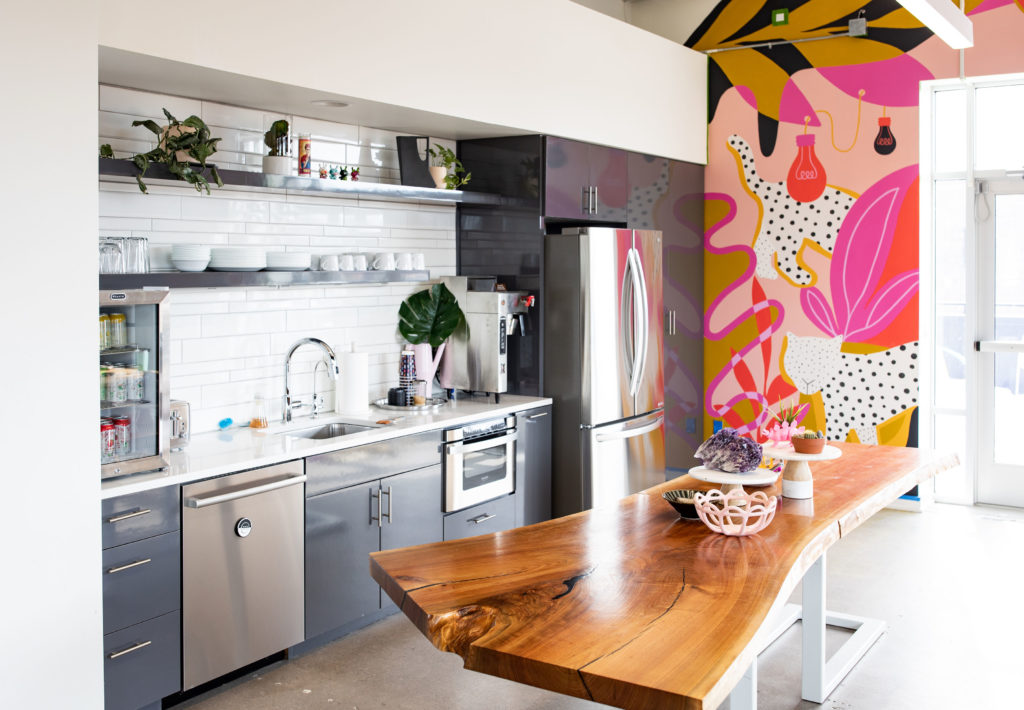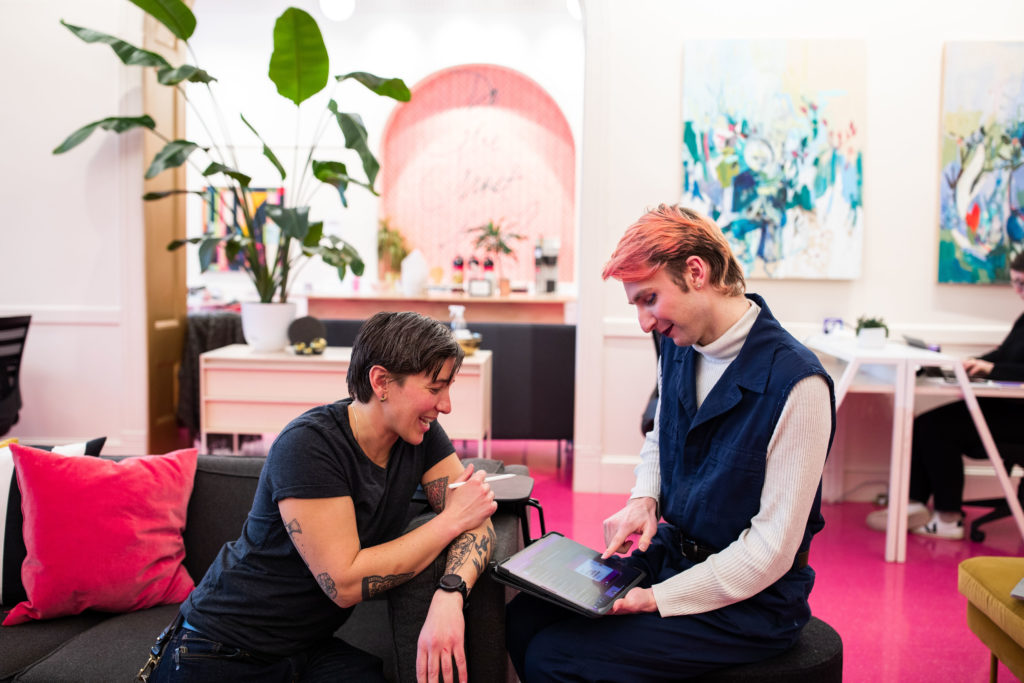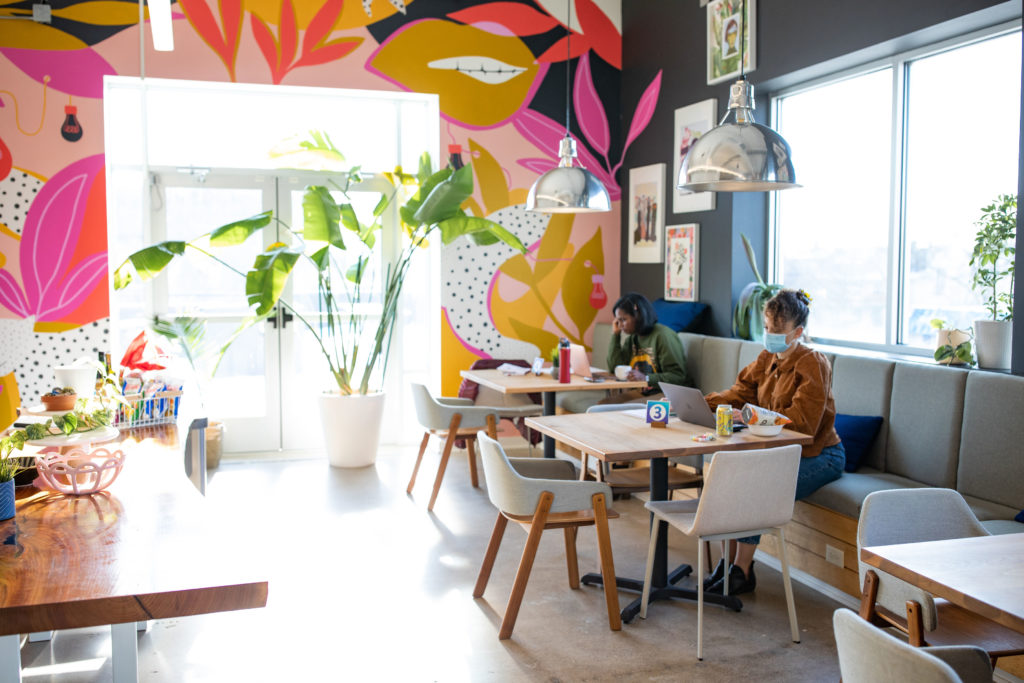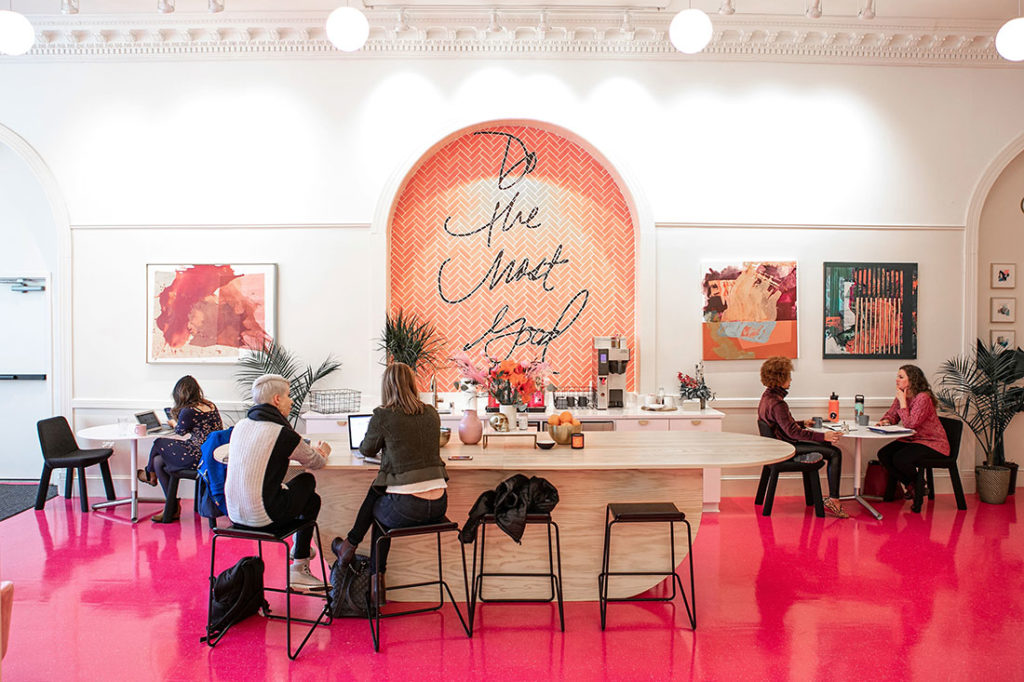During the past two decades, coworking spaces have provided companies, entrepreneurs and remote workers with a different way to work—one that’s convenient and flexible, has low overhead and sidesteps many of the challenges of the traditional office setting. These spaces have become an increasingly popular refuge between the distractions inherent at home and the many unappealing aspects of office life, two minefields that can be particularly taxing on one half of the current workforce: women.
In traditional workplace settings, office and company culture tend to dictate how colleagues interact—and how employees spend two-thirds of their waking hours. For nonmale workers, office culture can leave much to be desired.
The office is still a largely male-dominated space. In the U.S., men earn 16% more than women, lead 85% of Fortune 500 companies and make up four-fifths of total C-suite positions. Studies have shown that women are less likely to be promoted, less likely to get raises they ask for and—perhaps unsurprisingly—more likely to burn out than their male counterparts.

Even physically, offices are set up for male workers; one study found that office temperatures are set using a decades-old formula based on the ideal temperature for men. These temperatures increase their cognitive functioning and therefore performance, but decrease both for women, meaning offices biologically favor professional success for men.
The rise in working from home—a trend that seems here to stay in a post-pandemic landscape—has presented an attractive alternative to the office for many workers. However, women disproportionately face challenges at the home office too. In the U.S., women perform almost double the unpaid labor that men do, which includes child care, family care and housework and which can frequently impact their professional lives.
What if there were a different setting, one where women could focus on their work, network, collaborate and thrive—a space where men were not dominant; not centered; not the default?
This is the question some savvy entrepreneurs have answered with the increasingly popular female-centered coworking space. We talked to St. Paul- and Minneapolis-based The Coven about key trends and benefits of these spaces and how they make magic happen.
The Birth of a Modern Coven
Magic is transmuting desire into reality: You wish for something, and you make it happen. So the four founders of The Coven picked a good name. Five years ago, they were four friends in the advertising industry who were pouring their energies into creating programming and professional development for women—and running into roadblocks. There was a need, there was interest, but there was no investment.
“So we thought, We can just create the world that women, nonbinary and trans folks deserve to live in. We could create this in an office. And we didn’t want to create another advertising agency, we wanted to create a safe space,” Alex West Steinman, one of the co-founders, says.
To create this reality, The Coven’s founders hosted events and focus groups to crowdfund and crowdsource input on what the community most needed and wanted from such a space. The group’s ability to pre-sell memberships “told us that people really wanted something like this—and wanted to build it together,” Steinman says.
And so the coven set out to answer this question: What would it look like if we were included in the design of our spaces?

What happens when you create a female-centered space
In truly designing a space by and for the community, The Coven quickly demonstrated how centering women, trans and nonbinary folks not only solved challenges they were facing in traditional office settings but also inherently sparked conversations and demanded inclusivity for other marginalized workers.
Accurately and meaningfully representing their community in programming and events meant not just being gender-inclusive but also amplifying the voices of people of color. “Entrepreneurship is on the rise, and women of color are leading the way in entrepreneurial growth,” Steinman says. “We want to make sure our programming is representative and relevant for our members.”
While discussing physical aspects of the space such as milder temperatures (plus providing blankets), or lack of privacy for professionals who need space to breastfeed or pump, other considerations arose: size-inclusive seating for people with larger bodies, softer lighting and soundproofing for those with neurodivergence or sensory sensitivities.
“When you start to think about what are the best ways to support women, it expands from there quickly,” Steinman says. “How do we support more people? This comes from listening and asking our members—most of our ideas come directly from them, and then we bring them to life.”
By giving their community the opportunity to be co-creators of this space, The Coven strove to become a space where people are not just included but have a true sense of belonging and ownership.
“Most spaces are designed with solely productivity in mind. But how do you feel when you walk into the space? What would make you more comfortable, what would make you feel able to show up and be the best version of yourselves? No one has bothered to ask,” Steinman says. “We think about these things and then we act on it. Do you feel physically and psychologically safe so that you can speak up, take risks? These things are critical for entrepreneurs, leaders, nonprofits.”
Who can join a female-centered space
Remote workers, individuals, public and private companies, startups, nonprofits, entrepreneurs—these spaces cater to all. The Coven’s membership is about 50-50 entrepreneurs and employed, and the group is now seeing an influx in small- to midsize companies giving up office leases and offering their teams coworking options, which will enable companies to operate more flexibly and efficiently—and provide a more inclusive environment that’s able to address their employees’ needs.
“That’s an exciting opportunity for us,” Steinman says. “We’re here to stay and here to grow and see this new iteration of what it looks like to collaborate as an office team.”
Inclusivity means the spaces welcome people of all genders: “Everyone is invited, but we center our programming and space around women, nonbinary and trans folks, our core membership,” Steinman says. However, The Coven attracts plenty of male-identifying members who support the goals of the space and who have been surprised by how different—and how pleasant—an office can be.
“A lot of [men] choose to support our space because they support those people too and believe that most spaces have been designed specifically by men,” Steinman says. “So to have a space designed by those people feels very different.”

Finding community in the cloud
You don’t have to be physically present to be a member of a coven. The Coven has a thriving digital community that connects “like-hearted” individuals who cheer each other on, provide resources and funds, raise their hands to ask for support and find connection.
“Those are the things that make a difference,” Steinman says. “It’s not a passive community. It’s an active community. This is real support. You’re engaging with real human beings who are sharing their real, raw experiences. That element of community is beyond what people can honestly imagine in a digital space.”
This growing trend in coworking spaces allows them to extend their power beyond the physical spaces themselves and further opportunities for their communities.
Steinman says The Coven has multiple stories of people meeting by chance—“like someone asking to borrow a charger from someone else and the next thing you know they’re starting a business together.”
The four founders affectionately called themselves the coven even before starting the business. “It comes from the idea that when women, trans and nonbinary folks come together, they make magic. And when we convene, a lot of amazing, serendipitous things happen.”
This article originally appeared in the September/October 2022 issue of SUCCESS magazine. Photos by Bethany Birnie/Courtesy the Coven



